Intel Core i7 4960X (Ivy Bridge E) Review
by Anand Lal Shimpi on September 3, 2013 4:10 AM EST- Posted in
- CPUs
- Intel
- Ivy Bridge
- Ivy Bridge-E
Visual Studio Compile
Our compile test is back and better than ever. With a much larger and faster SSD (Samsung SSD 830, 512GB), we're able to get more consistent compile times between runs. We're now using Visual Studio 2012 to compile Mozilla's Firefox project. The compile is multithreaded however there are periods of serial operation where performance is bound by the speed of a single core. The end result is a benchmark that stresses both single and multithreaded performance. Compile times are reported in minutes elapsed.
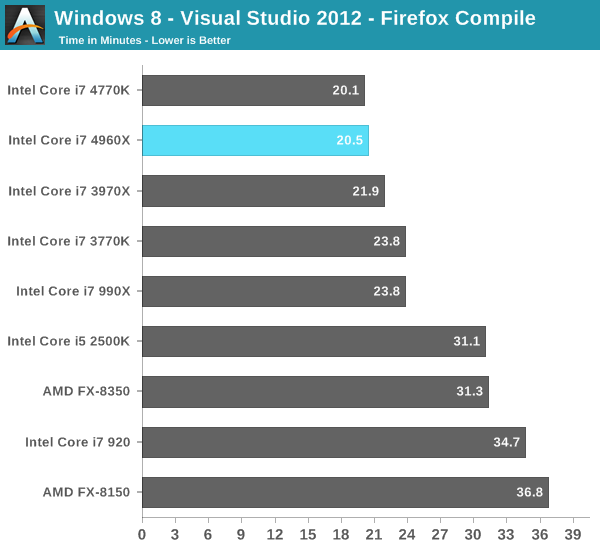
It's clear that IVB-E holds the advantage over Haswell when faced with heavily threaded workloads, but what about those workloads that are a good mix of both light and heavily threaded tasks? A medium-threaded workload if you will. It turns out our Firefox compile test is just that. Haswell's architectural improvements seem to do wonders for this test (under OS X as well), giving the 4770K a 16% lower compile time than Ivy Bridge. IVB-E on the other hand throws more cores at the problem, effectively equaling Haswell's performance but not exceeding it. In this case, if the rest of your applications are better threaded/demand more cores then IVB-E is the right solution for you. If, however, building Visual Studio projects is the most thread heavy thing you do then Haswell is a better option.
Photoshop
To measure performance under Photoshop CS4 we turn to the Retouch Artists’ Speed Test. The test does basic photo editing; there are a couple of color space conversions, many layer creations, color curve adjustment, image and canvas size adjustment, unsharp mask, and finally a gaussian blur performed on the entire image.
Time is reported in seconds and the lower numbers mean better performance. The test is multithreaded.
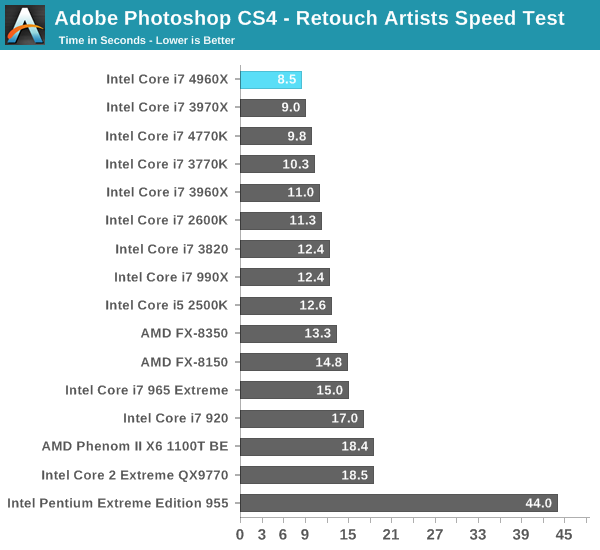
Our Photoshop test provides another example of an application with both lightly and heavily threaded behaviors. In this case, our Photoshop test favors the latter as the 4960X manages a 13% performance advantage over the 4770K. Once again the IVB-E advantage over SNB-E is around 5%.
File Compression/Decompression
The 7-zip benchmark is a CPU bound multithreaded integer workload that looks at 7-zip compression/decompression algorithms where the IO subsystem is removed from the equation:
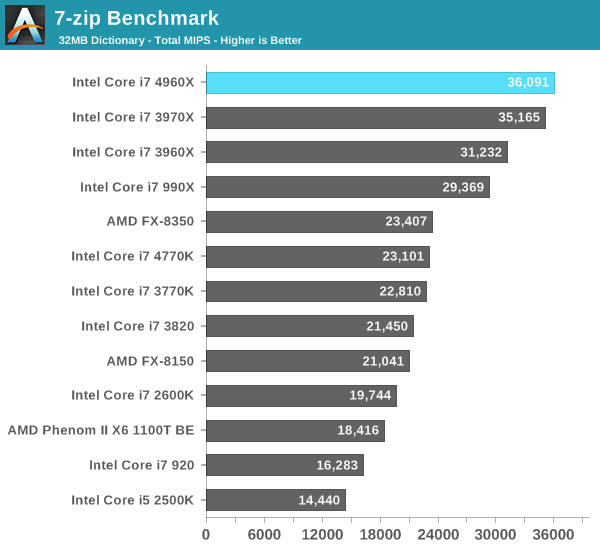
In its biggest advantage so far, the 4960X outperforms the 4770K by 56% in the 7-zip test. The IVB-E performance advantage compared to SNB-E shrinks to under 3% here. Heavily threaded integer workloads are also well suited for AMD's FX architecture. Here the FX-8350 is able to equal Haswell's performance.
Next up is our old Par2 test. Par2 is an application used for reconstructing downloaded archives. It can generate parity data from a given archive and later use it to recover the archive. Chuchusoft took the source code of par2cmdline 0.4 and parallelized it using Intel’s Threading Building Blocks 2.1. The result is a version of par2cmdline that can spawn multiple threads to repair par2 archives. For this test we took a 708MB archive, corrupted nearly 60MB of it, and used the multithreaded par2cmdline to recover it. The scores reported are the repair and recover time in seconds.
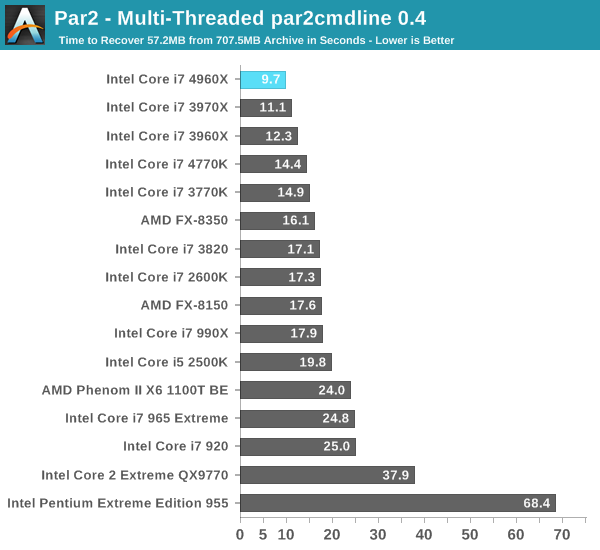
Here's another heavily threaded workload that does very well on the 4960X. We also see a rare situation where IVB-E increases performance over SNB-E by more than 10%.
Excel - Heavy Math
In our final CPU centric test we're running a monte carlo simulation on a large Excel spreadsheet. The process is well threaded.
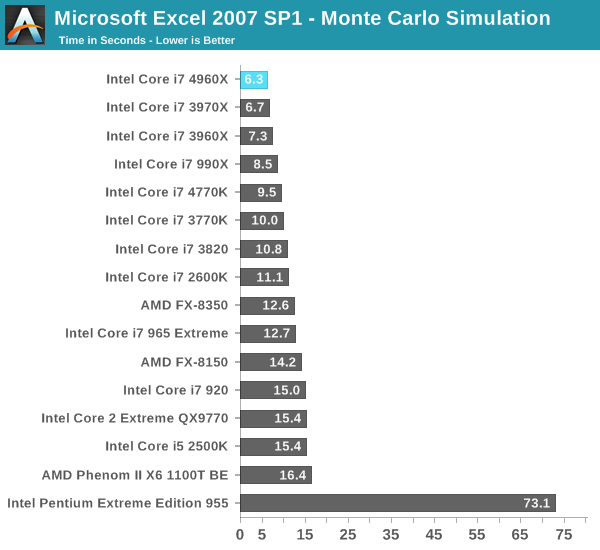
With 50% more cores, the 4960X delivers 33% better performance than the 4770K. If running multithreaded math workloads is up your alley, there's no alternative to the 6-core extreme edition parts.










120 Comments
View All Comments
madmilk - Tuesday, September 3, 2013 - link
If you invested in the 980 or the 970 (not the extreme ones) you got an awesome deal. Three years old, $600, overclockable, and within 30% of the 4960X on practically everything.bobbozzo - Tuesday, September 3, 2013 - link
True, but my Haswell i5-4670k was around $200 for the CPU (on sale), and under $150 for an ASUS Z87-Plus motherboard.It's running on air cooling at 4.5/4.5/4.5/4.4GHz.
I wasn't expecting it to be as fast for gaming as an i7-4770k, but looking at the gaming benchmarks in this article, I'm extremely pleased that I did not spend more for the i7.
althaz - Tuesday, September 3, 2013 - link
I had a launch model Core 2 Duo (the E6300) that with overclocking (1.86Ghz => 2.77Ghz) was a pretty decent CPU until last year (when I replaced it with an Ivy Bridge Core i5). That's what? Six years out of the CPU and it's still going strong for my buddy (to whom it now belongs).Kevin G - Tuesday, September 3, 2013 - link
"My biggest complaint about IVB-E isn't that it's bad, it's just that it could be so much more. With a modern chipset, an affordable 6-core variant (and/or a high-end 8-core option) and at least using a current gen architecture, this ultra high-end enthusiast platform could be very compelling."I think that you answered why Intel isn't going this route earlier in the article. Consumers are getting the smaller 6 core Ivy Bridge-E chip. There is also a massive 12 core chip due soon for socket 2011 based servers. Harvesting an 8 core versions from the 12 core die is an expensive proposition and something Intel may not have the volumes for (they're not going to hinder 10 and 12 core capable dies to supply 8 core volumes to consumers). Still, if Intel wanted to, they could release an 8 core Sandy bridge-E chip and use that for their flag ship processor since the architectural differences between Sandy and Ivy Bridge are minor.
The chipset situation just sucks. Intel didn't even have to release a new chipset, they could have released an updated X79 (Z79 perhaps?) that fixed the initial bugs. For example, ship with SAS ports enabled and running at 6 Gbit speeds.
Sabresiberian - Tuesday, September 3, 2013 - link
"The big advantages that IVB-E brings to the table are a ridiculous number of PCIe lanes , a quad-channel memory interface and 2 more cores in its highest end configuration."I'm going to pick on you a little bit here Anand, because I think it is important that we convey an accurate image to Intel about what we as end-users want from the hardware they design. 40 PCIe 3.0 lanes is NOT "ridiculous". In fact, for my purposes I would call it "inadequate". Sure, "my purposes" are running 3 2560x1440 screens @ 120Hz and that isn't the average rig today, but I want to suggest it isn't far off what people are now asking for. We should be encouraging Intel to give us more PCIe connectivity, not implying we have too much already. :)
canthearu - Tuesday, September 3, 2013 - link
Actually, you would find that you are still badly limited by graphics power, rather than limited by system bandwidth.A modern graphics card doesn't even stress out 8 lanes PCIe 3.0.
I'm also not saying that it is a bad thing to have lots of I/O, It isn't. However you do need to know where your bottlenecks are. Otherwise you spend money trying to fix the wrong thing.
The Melon - Tuesday, September 3, 2013 - link
Not all high bandwidth PCI-e cards are graphics cards.I for one would like to be able to run 2x PCIe x16 GPU's and at least 1 each of LSI SAS 2008, dual port DDR or QDR Infiniband, dual port 10GBe and perhaps an actual RAID card.
Sure that is a somewhat extreme example. But you can only run one of the expansion cards plus 2 GPU before you run out of lanes. This is an enthusiast platform after all. Many of us are going to want to do Extreme things with it.
Flunk - Tuesday, September 3, 2013 - link
Now you're just being silly, sending $10,000 on a system without any real increase in performance for anything you're going to do on a desktop/workstation is just stupid.Besides, if you're being incredibly stupid you'd need to go quad Xeons anyway (160 PCI-E lanes FTW).
Azethoth - Tuesday, September 3, 2013 - link
On the one hand, good review. On the other hand, my dream of a new build in the "performance" line is snuffed out. It just seems so lame making all these compromises vs Haswell, and basically things will never get better because the platform target is shifting to mobile and so battery life is key and performance parts will just never be a focus again.f0d - Tuesday, September 3, 2013 - link
i feel the same waythe future doesnt look too bright for the performance enthusiast - i dont want low power smaller cpu's i want BIG 8/12 core cpus and i dont really give a crap about power usage